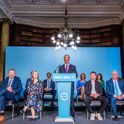In February, the UK government announced a reduction in the overseas aid budget, from 0.5 to 0.3 per cent of GDP in 2027, in order to fund higher defence spending. With lower resources on the horizon, how should aid agencies and charities adapt? Ian Mitchell of the Center for Global Development speaks to Policy Insights about what makes an effective aid provider.
Putting aside the imminent cut to aid and development, is the UK an effective provider?
Ten years ago you could probably have said the UK was the most effective provider of finance in terms of quality. On the whole, the Department for International Development (DfID) was highly effective. They paid attention to evidence, they were good at monitoring practices, they were focused on the countries that really need aid.
More recently that effectiveness has eroded. The UK has been less focused on the poorest countries. The merger of DfID into the foreign office in 2020 followed by the aid cut from 0.7 per cent of gross national income (GNI) to 0.5 per cent in 2021 created a high level of disruption from which there hasn’t been a full recovery. It’s true that Andrew Mitchell returned as development minister in 2022 and made some repairs, refocusing money towards the poorest countries but the UK is a long way from where it was a decade ago.
What makes good development policy?
Giving multilaterally to the best multilateral organisations is really important, and I’m really glad the UK government has retained that mission. Gavi and The Global Fund—the big health multinationals—can save lives at very low cost. The other very effective institution is the World Bank’s International Development Association. It works directly with countries at scale and tries to make a difference to their economies. It focuses on those countries that need it, it pays attention to what they want and it gives those countries ownership.
Another criteria we think about when we are looking at quality is the transparency of what’s being done.
What is the likely impact of the cut in budget to 0.3 per cent of GNI?
Broadly speaking you can’t do more with less but it’s possible you might find some marginal gains. For example, we give nearly half a billion pounds of the aid budget to upper-middle income countries, the likes of Columbia and Turkey. If you were willing to put an end to that funding, you could do so much more with that money. But it remains to be seen if there’s a political appetite to make that change. The same applies to the money that goes to refugees in the UK. These things are deeply political. As much as David Lammy, the foreign secretary, says he wants a new aid relationship, he also wants to be able to go to Brazil, say, and deliver some shared projects. These things all add up.
So there are some realistic things the UK could do better at the margins but the suggestion you can do more with less is a non-starter.
What impact did the folding of DfID into the foreign office in 2020 have on the UK’s ability to act effectively?
I’m perhaps slightly less negative about the demise of DfID than others. Having said that, the merger was shambolic. It was done for political purposes, neither of the departments was ready and it had real operational impacts. At the time, we were trying to bring people out of Afghanistan, and the idea that the merger didn’t impact that is mad.
The immediate period afterwards saw a really big cut from 0.7 per cent of GNI to 0.5 per cent of GNI. That took place in a new operating environment—and was poorly done. Having said that, Andrew Mitchell’s reforms as international development minister from 2022—reorganising the department so you now have a second permanent secretary focussed on development and creating much clearer lines of responsibilities—made a big difference.
But overall we’ve lost a separate, dedicated department that attends cabinet. There are so many people around the cabinet table and only the foreign secretary is speaking internationally. Today, Germany remains the sole major donor country with a dedicated development ministry.
If you had a blank piece of paper, albeit with no additional budget, what might you do to improve the UK’s effectiveness?
I’d be inclined not to set budget allocations upfront. Better to have conversations with recipient countries to understand what they need, and then allocate bottom up rather than top down.
Also, we need to be clearer when it comes to the parameters of aid. The UK is currently spending almost a third of its aid budget inside the UK, covering the home office’s costs when it comes to supporting and housing asylum seekers and refugees. The definition of official development assistance specifies that it must target the welfare of developing countries. What on earth has hosting refugees in this country got to do with that definition? Finally, there are a lot of policies that matter beyond aid—including trade, investment and research—and the UK could be much more proactive about using those policies to encourage growth in developing partner countries.
Lammy has called for “a long overdue conversation about the future architecture of aid” and for spending to be “smarter and sharper”. Is he right and how would it work in practice?
I think the foreign secretary is onto something but if he follows it through it is likely to mean less money for NGOs in the UK and more money for countries that the public may not trust. A very high proportion of the UK’s aid budget goes first to UK-based organisations, and then overseas. But other countries are better at getting their budget to local international partners. I’m not sure the foreign secretary is serious about changing that but I’d like to be wrong.
Public perceptions of aid don’t appear to be particularly positive. Asked prior to June’s spending review where cuts should be made, foreign aid was top of the list according to a YouGov poll. Why are perceptions so poor?
The why is relatively easy to answer. The UK has not seen growth in its prosperity in the last 15 years or so. Since the financial crisis, incomes per head have not gone up. As incomes rise, the amount countries give in aid as a share of GNI tends to go up, too. Right now, people don’t feel well off. And because we borrow every month as a country, to borrow in order to send money overseas is a very difficult sell.
It is worth pointing out that there is a regular survey from UCL and the University of Birmingham that tells a slightly different story. The survey shows the aid budget as a share of public spending and asks the public whether they would keep it at its current level, increase it or decrease it. Support has gone down over time but still around half of people would keep it at the current level or increase it. There’s still significant support for providing aid in the UK. Ministers shouldn’t ignore that support among their core voters.
How should the UK government counter these poor perceptions?
There is public support for basic services, for the more charitable objectives of aid and development. Framing aid and development as in the national interest, as a means of stopping migration, or for our own health and security? People just don’t buy it. They don’t think it’s what aid is for. So if you want to maintain and grow support for the aid budget, you need to go back to basics and tell people: “We are saving lives with this money, we are supporting the people that really need it, and we’re making concrete progress against these achievable goals.” The national interest argument tends to appeal to MPs more than it does to the public.













